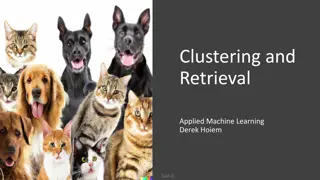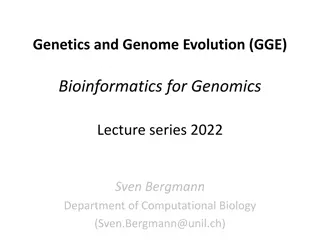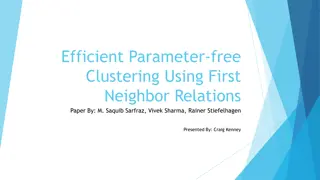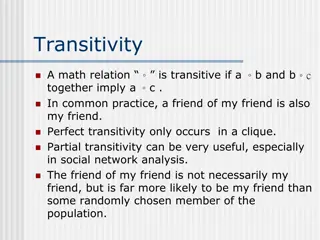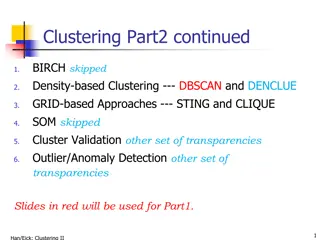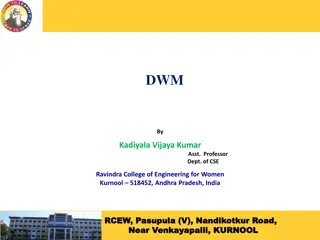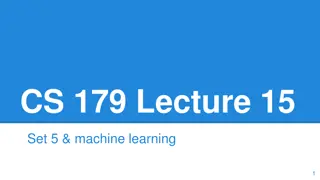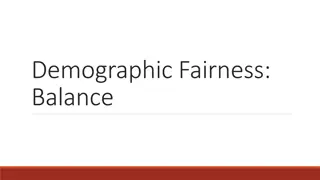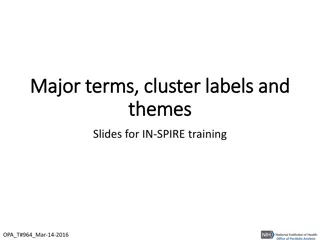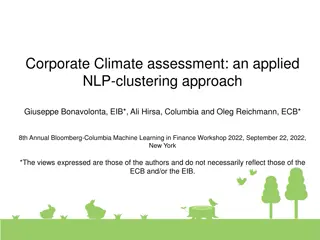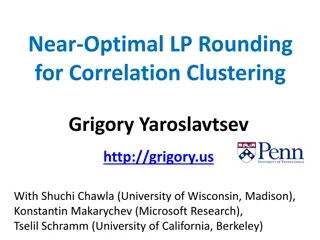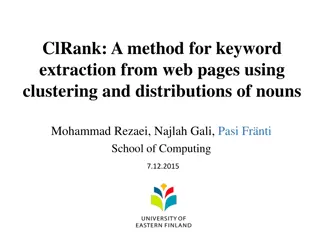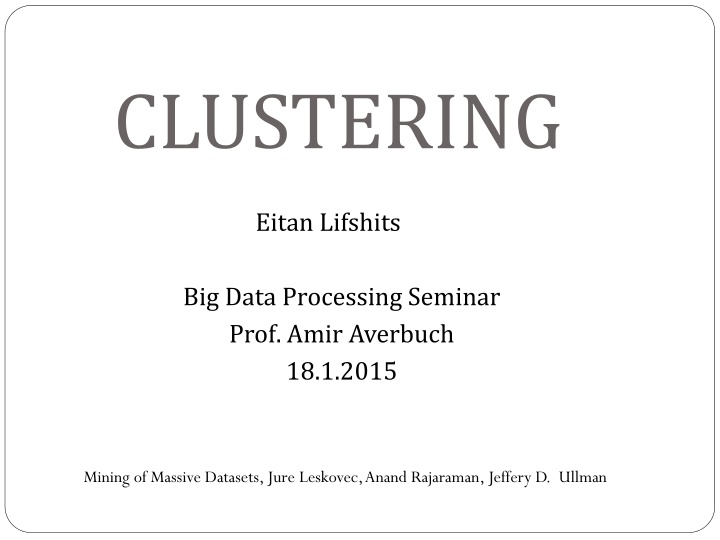
Clustering in Big Data Processing: Overview & Algorithms
Explore the concept of clustering in big data processing, covering topics such as distance measures, algorithmic approaches, and the challenges of high-dimensional data. Learn about hierarchical clustering, point assignment algorithms, and different distance measures like Euclidean, Jaccard, and Cosine. Understand the key distinctions between clustering algorithms and their applicability in various data settings.
Download Presentation

Please find below an Image/Link to download the presentation.
The content on the website is provided AS IS for your information and personal use only. It may not be sold, licensed, or shared on other websites without obtaining consent from the author. If you encounter any issues during the download, it is possible that the publisher has removed the file from their server.
You are allowed to download the files provided on this website for personal or commercial use, subject to the condition that they are used lawfully. All files are the property of their respective owners.
The content on the website is provided AS IS for your information and personal use only. It may not be sold, licensed, or shared on other websites without obtaining consent from the author.
E N D
Presentation Transcript
CLUSTERING Eitan Lifshits Big Data Processing Seminar Prof. Amir Averbuch 18.1.2015 Mining of Massive Datasets, Jure Leskovec, Anand Rajaraman, Jeffery D. Ullman
Main Topics What is Clustering? Distance measures and spaces. Algorithmic approaches. The curse of dimensionality. Hierarchical clustering. Point assign clustering. non-main-memory data clustering. Summary and other topics.
What is Clustering? The process of examining a collection of points and grouping them into clusters according to some distance measure. The goal is that points in the same cluster have a small distance from one another, while points in different clusters are at large distance from one another. Main issues Data is very large. High dimensional data space. Data space is not Euclidean (e.g. NLP problems).
Clustering illustration Example of data clustered into 3 clusters based on Euclidean space.
Distance measures and spaces Distance measure requires 3 conditions (was given in previous lectures) Distances examples: Euclidean distance (for set of points). Given by:
Distance measures and spaces Jaccard distance (for sample sets). Given by Cosine distance (for sets of vectors) Given by Edit distance (comparing strings) Given two strings a and b. The edit distance is the minimum number of operations (insertion, deletion, substitution) that transform a into b. And many more
Algorithmic Approaches There are two main approaches: Hierarchical algorithms: Agglomerative (bottom-up): Start with each point as a cluster. Clusters are combined based on their closeness , using some definition of close (will be discussed later). Divisive (top-down): Start with one cluster including all points and recursively split each cluster based on some criterion. Will not be discussed in this presentation. Point assignment algorithms: Points are considered in some order, and each one is assigned to the cluster into which it best fit.
Algorithmic Approaches Other clustering algorithms distinctions: Whether the algorithm assumes a Euclidean space, or whether the algorithm works for arbitrary distance measure (as those mentioned before). Whether the algorithm assumes that the data is small enough to fit in main memory, or whether data must reside in secondary memory primarily.
The curse of dimensionality Refers to high dimensional data properties which might make the clustering task much harder or yield bad results. Properties: In high dimensional data all points are equally far away from one another. Consider points where and is large, that were selected uniformly from a dimensional unit cube. Each point is a random variable chosen uniformly from the range [0,1].
The curse of dimensionality The Euclidean distance between two points is: If the dimension is high, we can expect that for some . That puts a lower bound of between almost any two points. The upper bound is given by Further calculations gives stronger bounds. Hence, it should be hard finding clusters among so many pairs that are all in approximately the same distance. Should be handled by dimensionality reduction methods.
Hierarchical Clustering We first consider Euclidean space. The algorithm: -While stop condition is false Do -Pick the best two clusters to merge. -Combine them into one cluster. -End;
Hierarchical Clustering Three important questions: 1. How do you represent a cluster with more than one point? 2. How will you choose which two clusters to merge? 3. When will we stop combining clusters?
Hierarchical Clustering Since we assume Euclidean space, we represent a cluster by its centroid or average of points in the cluster. Of course that in clusters with one point, that point is the centroids. Merging rule: merge the two clusters with the shortest Euclidean distance between their centroids. Stopping rules: We may know in advance how many clusters there should be and stop where this number reached. Stop merging when minimum distance between any two clusters is greater than some threshold.
Hierarchical Clustering Hierarchical Clustering- -Tree representation Tree representation The tree representing the way in which all the points were combined. That may help making conclusions about the data together with how many clusters there should be.
Hierarchical Clustering Hierarchical Clustering Controlling clustering Controlling clustering Alternative rules for controlling hierarchical clustering: Take the distance between two clusters to be the minimum of the distances between any two points, one chosen from each cluster. For example in phase 2 we would next combine (10,5) with the two points cluster . Take the distance between two clusters to be the average distance between all pair of points, one from each cluster. The Radius of a cluster is the maximum distance between all the points and the centroid. Combine the two clusters whose resulting cluster has the lowest radius. May use also average or sum of squares of distances from the centroid.
Hierarchical Clustering Hierarchical Clustering Controlling clustering Controlling clustering Continuation. The Diameter of a cluster is the maximum distance between any two points of the cluster. We merge those clusters whose resulting cluster has the lowest diameter. For example, the centroid of the cluster in step 3 is (11,4), so the radius will be And the diameter will be
Hierarchical Clustering Hierarchical Clustering Stopping rules Alternative stopping rules. Stop if the diameter of cluster results from the best merger exceeds some threshold. Stop if the density of the cluster that results from the best merger is lower than some threshold. The density may be defined as the number of cluster points per unit volume of the cluster. Volume may be some power of the radius or diameter. Stop when there is evidence that next pair of clusters to be combined yields bad cluster. For example, if we track the average diameter of all clusters, we will see a sudden jump in that value when a bad merge occurred. Stopping rules
Hierarchical Clustering in Non Hierarchical Clustering in Non- -Euclidean spaces spaces Euclidean Main problem: We use distance measures such as mentioned at the beginning. So we can t base distances on location of points. The problem arises when we need to represent a cluster, Because we cannot replace a collection of points by their centroid. Euclidean space Strings space (edit distance)
Hierarchical Clustering in Non Hierarchical Clustering in Non- -Euclidean spaces spaces Euclidean Example: Suppose we use edit distance, so But there is no string represents their average. Solution: We pick one of the points in the cluster itself to represent the cluster. This point should be selected as close to all the points in the cluster, so it represent some kind of center . We call the representative point Clustroid.
Hierarchical Clustering in Non Hierarchical Clustering in Non- -Euclidean spaces spaces Euclidean Selecting the clustroid. There are few ways of selecting the clustroid point: Select as clustroid the point that minimize: 1. The sum of the distances to the other points in the cluster. 2. The maximum distance to another point in the cluster. 3. The sum of the squares of the distances to the other points in the cluster.
Hierarchical Clustering in Non Hierarchical Clustering in Non- -Euclidean spaces spaces Example: Euclidean Using edit distance. Cluster points: abcd, aecdb, abecb, ecdab. Their distances: Applying the three clustroid criteria to each of the four points:
Hierarchical Clustering in Non Hierarchical Clustering in Non- -Euclidean spaces spaces Euclidean Results: For every criteria selected, aecdb will be selected as clustroid. Measuring distance between clusters: Using clustroid instead of centroid, we can apply all options used for the Euclidean space measure. That include: The minimum distance between any pair of points. Average distance between all pair of points. Using radius or diameter (the same definition).
Hierarchical Clustering in Non Hierarchical Clustering in Non- -Euclidean spaces spaces Euclidean Stopping criterion: Uses criterions not directly using centroids, except the radius which is valid also to Non-Euclidean spaces. So all criterions may be used for Non-Euclidean spaces as well.
Point assign algorithms Point assign algorithms
K K Means Algorithms Means Algorithms Best known point assignment clustering algorithms. Works well in practice. Assume a Euclidean space. Assume the number of clusters K is known in advanced.
K K Means Algorithm Means Algorithm The algorithm: Initially choose k points which are likely to be in different clusters; Make this points the centroids of this clusters; FOR each remaining point p DO Find the centroids to which p is closest; Add p to the cluster of that centroid; Adjust the centroid of that cluster to account for p; END; Optional: Fix the centroids of the clusters and assign each point to the k clusters (usually does not influence).
K K Means Algorithm Means Algorithm Illustration (similar to our algorithm):
K K Means Algorithm Means Algorithm Initializing clusters. Few approaches: Pick points that are as far away from one other as possible. Cluster a sample of the data (perhaps hierarchically) so there are k clusters. Pick a point from each cluster (perhaps that point closest to cluster centroid). Algorithm for the first approach: Pick the first point at random; WHILE there are fewer than k points DO Add the points whose minimum distance from the selected points is as large as possible; END;
K K Means Algorithm Means Algorithm Example for initializing clusters: We have the following set: We first the worst case point, which is (6,8). That s the first point. The furthest point from (6,8) is (12,3), so that s the next point.
K K Means Algorithm Means Algorithm Now, we check the point whose minimum distance to either (6,8) or (12,3) is the maximum. d((2,2),(6,8)) = 7.21, d((2,2),(12,3)) = 10.05. So, the score is min(7.21, 10.05)= 7.21.
K K Means Algorithm Means Algorithm Picking the right value of k: Recall measures of appropriateness of clusters , i.e. radius or diameter. We run k-means on series of numbers, say 1, ,10, and search for significant decreasing in the clusters diameters average, where afterwards it doesn t change much.
BFR Algorithm BFR Algorithm
BFR Algorithm BFR Algorithm BFR (Bradley Fayyad Reina) is a variant of k means, designed to handle very large (disk resident) data sets. Assumes that clusters are normally distributed around a centroid in a Euclidean space. Standard deviation In different dimensions may vary. For example if d=2, we get an ellipse along with the axes.
BFR Algorithm BFR Algorithm Points are read one main-memory-full at a time. Most points from previous memory loads are summarized by simple statistics. To begin, from the initial load we select the initial k centroids by some sensible approach.
BFR Algorithm BFR Algorithm Initialization: As similar to k means: Take a small random sample and cluster optimally. Select points which are far from one another as in the k-means algorithm.
BFR Algorithm BFR Algorithm The main memory data uses three types of objects: The Discard Set: Points close enough to a centroid to be summarized (how to summarize will be defined later). The Compression Set: Groups of points that are close together but are not close to any centroid. They are summarized, but not assigned to a cluster. The Retained Set: Isolated points. How to summarize will explained later.
BFR Algorithm BFR Algorithm Processed point representation in memory:
BFR Algorithm BFR Algorithm Summarizing sets of points: For the Discard Set, each cluster is summarized by: The number of points N. The vector SUM whose i-th component is the sum of coordinates of the points in the i-th dimension. The vector SUMSQ whose i-th component is the sum of squares of coordinates in the i-th dimension.
BFR Algorithm BFR Algorithm Why use such representation? 2d+1 values represent any size cluster, where d is the number of dimensions. Average of each dimension (centroid) can be calculated as as defined above. Variance of each dimension in a cluster may calculated as for the i-th coordinate. Standard deviation is the square root of that. Such representation give us a straightforward way of calculatind the centroid and std. of a cluster for any marginal points addition.
BFR Algorithm BFR Algorithm Processing a chunk of points (memory-load) data: Find those points that are sufficiently close to a cluster centroid. Add those points to that cluster and the Discard Set. Use any main-memory clustering algorithm to cluster the remaining point and the old Retained Set. Clusters go to Compress Set. Outlying points go to the Retained Set. Adjust statistics of the clusters to account for the new points. Add N s, SUM s and SUMSQ s. Consider merging compressed sets in the Compressed Set.
BFR Algorithm BFR Algorithm Continuation: If this is the last round, merge all compressed sets in the Compressed Set and all Retained Set points into their nearest cluster. Comment: In the last round we may treat the Compressed and Retained sets as an outliers and never cluster them at all.
BFR Algorithm BFR Algorithm Assigning new point - How Close is close enough? Mahalanobis Distance: Normalized Euclidean distance from centroid. For point and centroid The Mahalanobis distance between them is
BFR Algorithm BFR Algorithm Mahalanobis distance illustration:
BFR Algorithm BFR Algorithm Assigning new point using Mahalanobis Distance: If the clusters are normally dist. In d dimensional, than after transformation one std. equals . That means that approximately 70% of the points of the cluster will M.D < . Assigning rule: Assign new point to a cluster if its M.D < threshold. Threshold may be 4 std. In normal dist. 3 std. distance include around 99.7% of the points. Thus, with that threshold there is a very small chance to reject a point that truly belong to that cluster.
BFR Algorithm BFR Algorithm Merging two compressed sets: Calculate the variance of the combined cluster. We can easily do that using the clusters representation mentioned before. Merge if variance is below some threshold.
Summary and further topics So far we handled: Hierarchical clustering, assuming Euclidean space and main- memory-fit data. Hierarchical clustering using arbitrary distance measure. Point assign clustering, assuming Euclidean space and main- memory-fit data. Point assign clustering, assuming Euclidean space and very large data sets (data reside in secondary memory).
Summary and further topics Further topics may be: The CURE (Clustering Using Representatives) algorithm: Does similar job as BFR, but without restrictions on the clusters shape. The GRGPF (named after its authors) algorithm: Also deal with very large data sets and may work with an arbitrary distance measures. Clustering streams: Assuming sliding window of points, where we have access to a smaller number of last points. Answering queries: Use stream clustering strategy to answer queries. Clustering using MapReduce: Divide the data into chunks and cluster each chunk in parallel using a Map task.


